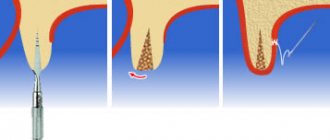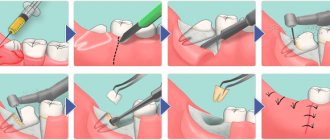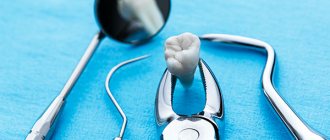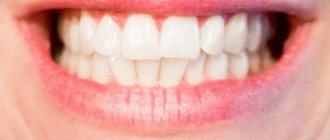Also watch: Important questions about anesthesia and sedationTeeth extraction under sedationCost of sedationWhat is drug-induced sleep in dentistry
For many people, dental implantation is the most reliable and optimal option for restoring the dentition. There are several types of dental implantation, the fastest of which is considered to be one-stage implantation. The peculiarity of this manipulation is that tooth extraction and implant installation occur immediately one after the other during one visit to the dentist. It is when carrying out this type of intervention that painless tooth extraction before implantation, delicate and non-traumatic, is of great importance. Failure to comply with the tooth extraction technique before immediate implantation can become a serious obstacle to performing this procedure.
Also, minimal trauma during tooth extraction is important before other options for dental implantation, as well as before osteoplastic surgery. Modern dental clinics offer their patients quick and painless tooth extraction using modern equipment and painkillers. Non-traumatic tooth extraction and the absence of pain in the patient are prerequisites for successful subsequent implantation and prosthetics.
In what cases is simultaneous implantation indicated?
The main indication for simultaneous dental implantation is the loss of one or more teeth, provided that an important condition is met, namely, maintaining the required volume and strength of the jaw bone.
It is recommended to perform one-stage implantation with preliminary tooth extraction when:
- Traumatization, when part of the tooth is damaged and it is not subject to conservative treatment. As a rule, if you consult a dentist in a timely manner after an injury, the bone tissue does not have time to undergo pathological changes and simultaneous implantation is possible with non-traumatic and painless removal of the injured tooth;
- Advanced stages of caries, in which the inflammatory and destructive process does not affect bone tissue. If conservative methods of caries treatment cannot help the patient (most of the tooth crown is destroyed), then it is best to carefully remove the tooth and perform a one-stage implantation;
- The need to restore the dentition as quickly as possible. Single-stage implantation is considered the operation of choice for patients whose professional or social activities require constant contact with people, and therefore require an appropriate appearance. The efficiency of the procedure is the main advantage of one-stage implantation among other methods of dental restoration;
Tooth extraction followed by implant installation is possible only if several important conditions are met. In addition to the absence of atrophic processes in bone tissue, complete sanitation of the oral cavity and the absence of symptoms of inflammatory gum diseases and other dental pathologies are necessary. Therefore, in addition to delicate and low-traumatic tooth extraction before implantation, it is also important to comprehensively prepare the patient for the intervention in order to obtain the desired result from implantation and minimize possible risks.
Painkillers for self-removal of teeth
| A drug | Image | Price in Russia | Price in Belarus | Price in Ukraine |
| Efferalgan | 100 | 3,2 | 41 | |
| Panadol | 100 | 3,2 | 41 | |
| Nurofen | 100 | 3,2 | 41 | |
| Moment | 200 | 7 | 82 | |
| Spazgan | 150 | 5 | 61 | |
| Baralgetas | 150 | 5 | 61 | |
| Ketorol | 200 | 7 | 82 | |
| Paracetamol | 50 | 1,6 | 21 | |
| Tempalgin | 300 | 10 | 123 | |
| Analgin | 100 | 3,2 | 41 |
- How to pull out a baby tooth at home
Attention! When treating children, you should choose only those tablets that are recommended by dentists. When the dosage of adult analgesics is reduced, there is still a chance of developing side effects and problems with the gastrointestinal tract, liver and kidneys.
When is an intervention not recommended?
Despite the fact that one-stage implantation is considered the most convenient way to restore the dentition, its disadvantages include the presence of a large number of contraindications:
- Atrophic processes in bone tissue in the intervention area;
- The patient has osteoporosis;
- Diseases of the blood coagulation system;
- Endocrine pathologies (decompensated diabetes mellitus);
- Immunodeficiency conditions;
- Inflammatory gum diseases (relative contraindication, that is, the procedure is possible after the patient has completed the full course of treatment);
If there is at least one of the above contraindications, installing an implant immediately after tooth extraction is impossible and another treatment option is selected. Also, the process of tooth extraction itself in cases where the patient has these pathologies requires a special approach and is performed in the most gentle manner possible.
Contraindications: when tooth extraction is not permitted
It is not always possible to perform tooth extraction without pain. The procedure should be avoided if the patient:
- there are acute diseases;
- you are pregnant in the 1st or 3rd trimester;
- there are diseases with local skin lesions (herpes, fungus, syphilis);
- diagnosed with mental illness;
- have blood diseases,
- radiation therapy is performed;
- There are cancers that are treated with chemicals.
In such cases, it is better to postpone the extraction.
How is preparation carried out for tooth extraction and subsequent implantation?
Since the quality of implantation depends on how carefully the dentist removes the tooth, each patient is required to undergo thorough preparation for this procedure, which includes a preliminary examination and some preparatory manipulations:
- The degree of tooth destruction, the presence or absence of structural anomalies in the implantation area are assessed;
- Additional instrumental research methods are carried out: X-ray, CT. With their help, the doctor assesses the condition of the bone tissue, as well as the roots of the tooth, including their location in relation to the paranasal sinuses;
- Instruments for tooth extraction and the optimal method of pain relief for the patient are selected;
- A set of treatment measures is prescribed in the presence of concomitant dental pathologies;
- If necessary, professional teeth cleaning is performed, which can effectively reduce the risk of infectious complications during the rehabilitation period;
- The day before tooth extraction, in many cases antibiotic therapy with a broad-spectrum drug is prescribed;
Before tooth extraction, it is also very important to ensure the correct psychological attitude of the patient. To do this, the doctor must explain to the patient in detail how the procedure will be performed, why certain manipulations are performed, and what results should be expected after tooth extraction and implant installation. In addition, the patient must be explained what kind of anesthesia will be used during the operation and how it works.
A special place in preparation for tooth extraction is occupied by sedation of the patient. To conduct mild sedation, the doctor must take into account the psycho-emotional characteristics of the patient, the degree of his anxiety before the upcoming manipulation. In modern dentistry, safe and effective drugs are used to provide sedation, which quickly eliminate such undesirable manifestations as severe fear, psychomotor agitation and others. Without proper psychological preparation of the patient and well-chosen sedation, painless tooth extraction before implantation is very difficult to carry out delicately and non-traumatically.
Why does the tooth socket hurt and how to speed up the healing process.
After the removal procedure, the patient may experience discomfort in the oral cavity - this is quite natural, as our body reacts to loss. But problems can also be alarming in nature, when you should immediately consult a dentist.
Pain in the gums and swelling last on average up to 5-7 days. Soft and hard tissues have been injured and this is how they respond. The more difficult the removal, the worse the damage will be. If you do not have the strength to endure the pain that arises, use painkillers.
During the healing process, the hole should be filled with a blood clot; if it is not there, or the wound gets infected, a disease develops - alveolitis. This inflammation is accompanied by increasing pain and bad breath. This could be to blame
doctor and patient alike. During the operation, the dentist could partially remove the root, leaving a piece of it in the hole or not completely clean the wound from the cyst. And the patient, in turn, without observing the rules of hygiene, can “rinse out” the blood clot, emptying the hole. In any case, only a doctor can cure alveolitis; he will rinse the hole and fill it with medicine. At the A-medic clinic, the cost of treating alveolitis will be 1,200 rubles.
Some time after removal, the patient may experience bleeding. What should you do in this case? To begin with, you can try to stop the bleeding yourself by making a tampon from a sterile bandage and applying it tightly to the wound. If this does not help, use a hemostatic sponge. You should not expect the blood to stop flowing on its own; try to stop it; if there is no visible result, consult a doctor. One of the reasons for severe bleeding may be damage to blood vessels during the procedure.
For a speedy recovery, you should follow several rules; they will help you recover faster and significantly reduce pain:
- Eating food is allowed only 2-3 hours after the anesthesia wears off.
- Brush your teeth with a soft brush, avoiding direct contact with the socket. Rinse your mouth slowly, being careful not to wash out the blood clot.
- For about a week, you must refrain from eating hot food and visiting saunas and baths.
- In the first two days, do not drink alcohol or smoke.
- For a while, eliminate solid foods from your diet and eat more liquid and soft foods. Chew on the healthy side.
- Under no circumstances should you pick at the wound with foreign objects or touch it with your hands.
! Cleaning the oral cavity by rinsing, drinking a lot of water, spitting is not recommended in the first 3 days. You may damage or wash away the protective blood clot in the socket.
For rapid wound healing, treatment and prevention of alveolitis, the A-medic clinic uses a special dressing (alvogil) - this is a modern antiseptic analgesic compress that has an anti-inflammatory and analgesic effect.
How to remove a tooth without pain?
In modern dental practice, tooth extraction is not carried out without high-quality, reliable and safe anesthesia for the patient’s health. In the vast majority of cases, when removing teeth, local anesthesia is used, that is, the patient remains conscious both during pain relief and during further manipulations. To remove a tooth, dentists most often resort to the injection method of local anesthesia, when an anesthetic is injected into the desired area of tissue by injection. Using the injection method, infiltration and conduction local anesthesia can be performed, while conduction anesthesia is more suitable in cases where several teeth are to be removed at once.
To remove a tooth without unnecessary trauma to the surrounding tissues and without severe stress for the patient, it is necessary to select an effective painkiller. The most common are drugs based on novocaine, lidocaine, ultracaine and some other anesthetics. The main requirements for drugs for local anesthesia are a rapid onset of effect, reliability and a high safety profile.
Before anesthesia, a special sensitivity test to the anesthetic must be performed. This is necessary primarily in order to exclude the development of such severe allergic complications as Quincke's edema and anaphylactic shock. After the dentist is convinced that the drug is safe to use, they proceed directly to pain relief. Several injections are made into the gums, and the patient may notice minor soreness and discomfort, which pass fairly quickly. After the anesthesia begins to take effect, careful tooth extraction begins.
Proper oral care after tooth extraction
After tooth extraction, you should adhere to certain rules and recommendations of the dentist - they will help to avoid both discomfort and complications.
- You should not eat for several hours after the procedure. This can damage the surface of the gums that have not yet healed and cause infection.
- Carefully monitor the area where the tooth was - and if it bleeds heavily, consult a doctor.
- If necessary, you can take a pain reliever.
- Do not drink, smoke or eat hot food. All of these actions can help dissolve the blood clot that usually forms in the socket after a tooth is pulled out, which can lead to pain or increase the healing time of the gums.
- If the tooth extraction was complicated (surgically), after 24 hours you should start rinsing the damaged gum with a solution recommended by the dentist.
- Also, if you have a tooth removed surgically, you should not use a hard toothbrush or light mouthwash.
Of course, in most cases, after tooth extraction there is no pain or special discomfort. But to be sure of quick healing, you should follow these recommendations - and, of course, contact doctors from the President clinic. Also, after removal, you can contact our clinic for advice on prosthetics and implantation so that your smile remains the same
What is needed to prevent injury during tooth extraction?
The correct selection of instruments for tooth extraction before implantation is necessary in order to minimize the risk of trauma to the bone and soft tissues surrounding the tooth. Since even the slightest injury to the alveolar process of the bone makes it impossible to carry out implantation immediately after tooth extraction, dentists use exclusively modern equipment to make the process of tooth extraction as precise and non-traumatic as possible. These include:
- High quality tongs. Selecting the desired shape and bend of the forceps and using them carefully allows you to remove the tooth and tooth roots without injury;
- Periotomes. Used for atraumatic tooth extraction with delicate separation of marginal gums;
- Luxators. They are an improved version of classic elevators, significantly simplify the process of tooth extraction and make it less traumatic;
- Ultrasonic surgical devices, for example, piezotome. Allows you to minimize trauma during tooth extraction and facilitates the rehabilitation period for patients after implant installation;
The quality of the instruments determines how convenient it is for a specialist to perform the operation, which in turn is of great importance for preventing injury to bone tissue and obtaining a good result from dental implantation.
In addition to choosing the necessary tools, the experience and qualifications of the specialist are of great importance.
For an average surgeon, the remains of teeth before surgery are a hindrance and are not treated on ceremony. The result is broken bone structures of the jaw, wandering remnants of roots, unremoved cysts growing into the maxillary sinus, perforations, fistulas, osteomyelitis and much more. Not to mention the shocking post-operative pain that overtakes the patient after such punitive surgery. Entrust removal to an oral and maxillofacial surgeon. Only the maxillofacial surgeon has enough theoretical and practical skills to perform tooth extraction without complications.
General information.
There are two types of tooth extraction - simple and complex. They differ in the method of extraction and the use of different tools.
Simple.
It takes no more than 15-20 minutes. First, the doctor injects an anesthetic, then slightly loosens the tooth and uses special forceps to pull it out.
Chronically, periodontitis is an inflammatory process that destroys the functions of hard and soft tissues. Because of this, the tooth’s support and connection to the gum are disrupted and it becomes mobile. It will not be difficult for a doctor to remove it.
If the patient seeks help late or there is simply no opportunity to restore and cure the diseased tooth, in this case, all that remains is to pull it out. After this, the doctor performs a curettage procedure (cleansing the hole of pus), disinfects the wound and the oral cavity.
Complex (surgical).
Removal of: impacted, dystopic, fused with bone tissue, or acute chronic tooth disease requires staged surgical intervention using special equipment.
A tooth that has not fully erupted, or has not erupted at all, due to its irregular location, is called impacted. Most often, this problem concerns the third molars, but other units of the jaw system are not immune from this phenomenon. Sometimes, cutting the gum hood and further releasing the crown helps correct the defect, but most dentists resort to an extraction procedure. It is necessary when there is a risk of displacement of the remaining teeth relative to each other or the appearance of inflammatory processes. Extraction of “eights” requires preliminary preparation. To access the crown, the doctor cuts through the soft tissue and drills a hole in the bone. If the molar has reached a large size, it is cut into several parts and pulled out with special forceps. At the end of the operation, the oral cavity and wounds are treated with antiseptic agents.
Removing a dystopic (incorrectly located) tooth will be no different; it also includes several stages.
The development and extraction of wisdom teeth deserves a separate topic. This is a vestigial organ that has lost its significance in the process of evolution. Basically, they appear at the age of 12-26 years. The patient may not even realize that he has an eighth tooth in the row, since its presence in the jaw is difficult to feel or notice. Its development occurs almost asymptomatically. But that doesn't mean it doesn't cause problems. When the time comes and the third molar begins to erupt, the patient may experience inflamed gums, an increase in body temperature and constant pain.
Those who have tried to remove a wisdom tooth know how difficult and painful it is. But thanks to the use of modern painkillers, the patient does not feel anything at all. There is a difference in the extraction of the upper and lower rows of the dental system. The lower “eights” are much more difficult to pull out, due to their massive roots and dense soft tissues, so the difference in cost is quite justified.
Before the operation, an x-ray and anesthesia are taken, after which the dentist pulls out the tooth and places sutures at the extraction site.
Another procedure that is performed using only surgical treatment is called apex resection. It is required when the patient has an infectious disease and a cyst forms. The operation is carried out in several stages. First, the doctor must give an injection with anesthetics. The surgeon cuts the gum and bone tissue for an unhindered approach to the tumor. Carefully removes the cyst by cutting off part of the apex of the tooth root. Cleanses the wound from purulent residues and disinfects it. To restore and fill empty space in the bone, artificial synthetic material is used.
Complex extraction differs from simple extraction by the use of completely different devices and stronger painkillers. Often, the doctor has to perform complex surgical procedures, cut the gums, apply sutures and much more.
Modern dentistry has numerous possibilities, one of them is prosthetics. If a patient wants to restore a lost tooth with an artificial crown, an important condition will be the preservation of the bone and soft tissue around the hole. If something has been damaged, a restoration procedure is required. Therefore, you should choose clinics with a good reputation and trusted specialists who can perform the extraction efficiently and painlessly, regardless of its complexity.
Main stages of the intervention
Tooth extraction is a routine procedure for an experienced dentist. After carrying out a set of preparatory measures and pain relief, the doctor begins to directly remove the tooth. In most cases, the tooth extraction procedure consists of detaching the gums using a special tool, applying forceps to the tooth, and then gently loosening it. After the tooth becomes sufficiently mobile, it is removed from the socket, which is then carefully examined to prevent the presence of bone fragments in it. The final stage is the treatment of the tooth socket, the main purpose of which is to prevent infectious complications.
Sometimes complex tooth extraction may be necessary before implantation. This procedure is resorted to in cases where there are anomalies in the structure of the dentition or severe curvature of the tooth roots. For complex removals, the dentist uses additional instruments and the intervention requires a little more time. If the tooth extraction was atraumatic, the doctor begins the implantation procedure.
The following problems are typical for wisdom teeth:
- Development of caries or inflammation of soft tissues;
- Lateral growth causing injury to the oral mucosa, tongue and gums;
- Destruction of adjacent teeth due to improper growth of wisdom teeth;
- Severe pain due to the proximity of the facial nerve;
- Purulent lesions in the projection of the 8th tooth.
The cost of wisdom tooth removal is affordable for everyone. But the most important thing is the professionalism of doctors. Competent specialists work in our clinic. You can make an appointment with them today and solve your problem!
Why is it important to adhere to the low-impact principle?
Minimizing trauma to healthy tissues surrounding the tooth is a priority when removing a tooth of any degree of complexity. However, if this procedure is carried out immediately before implantation, then delicate and low-traumatic tooth extraction is necessary not only to protect the patient from unpleasant sensations, but also so that the dentist can reliably fix the implant in the bone tissue.
It is also very important to prepare the patient for the procedure, which, in addition to a comprehensive examination, may include mild sedation to eliminate psycho-emotional discomfort.
Sincerely, Levin D.V., chief physician
Indications: when removal is necessary
Teeth have to be removed due to infections in the mouth that destroy the teeth. It is important to identify and treat such diseases in a timely manner. When therapy does not solve the problem, the tooth has to be removed.
Indications for the procedure:
- inflammation in the mouth
- root fracture,
- destruction of roots,
- gum injury,
- the need to make an arch on the jaw.
Tooth extraction is indicated for patients with periodontitis, cysts, and advanced caries. To prevent the problem, you should carefully maintain dental hygiene. The following also lead to extraction: its fractures, loosening.
When is local anesthesia not used?
Contraindications to local anesthesia in dentistry
- Hypersensitivity to one of the components included in the anesthetic – a history of allergic reactions.
- Ineffectiveness of local anesthesia (for example, at the site of inflammation).
- Long duration and/or complexity of the intervention, the need to anesthetize a large number of anatomical structures or area of the surgical field.
The amount of drug used in this case will exceed the permissible amount and will have toxic and other side effects. Examples include:- operations for tumors;
interventions on the salivary glands;
- manipulations for traumatic injuries of the facial skeleton;
- orthognathic surgery – correction of bite by changing the position and size of jaw segments;
- craniofacial surgery.
- Insurmountable fear of treatment. In these cases, anesthesia is used - a type of general anesthesia, in which the patient is not conscious, or combined anesthesia with premedication - the use of drugs that induce a sleep-like state.
- Mental illness and behavioral disorders.
- Limited mouth opening. The following important points should be taken into account:
- the need to involve an anesthesiological team in the operation;
- potential risks during, before and after surgery;
- significantly higher price (sometimes exceeding the cost of treatment or comparable to it);
- representation mainly in Moscow and other large cities;
- the need for observation after recovery from anesthesia and surgery.
- A preliminary consultation and examination by an anesthesiologist is mandatory, who will determine the specific scheme for administering and maintaining anesthesia or another type of general anesthesia, medications and their dosage, etc. Taking into account ideas about the development of pain syndromes encountered during treatment, other groups of drugs are used:
- non-steroidal anti-inflammatory drugs;
- hormonal anti-inflammatory;
- antispasmodics;
- non-narcotic analgesics;
- narcotic analgesics;
- antidepressants.
Pain during dental treatment
What determines the occurrence of pain:
- On the patient's degree of susceptibility;
- Neglect of the problem;
- The presence of purulent inflammation;
- Depth of tooth damage;
- Location of roots and lateral branches;
- Whether the patient took alcohol and painkillers before visiting the doctor.
Enamel is the least sensitive. Its destruction increases the tooth's susceptibility to pain. There is no enamel below the gum level, so the discomfort is pronounced. It is impossible to treat the pulp without anesthesia, since this tissue is penetrated by nerve fibers.
Removal procedure
With the passage of time and the development of medical technology, the extraction technique has not changed at all. Of course, this is not one of those barbaric methods that were used in ancient times. Today, teeth are removed using forceps. There is simple and surgical removal, the first of which is necessary if the doctor has the opportunity to catch the instrument on the tip of the tooth that remains protruding from the gum.
The second is when the doctor has nothing to take on. Such situations require an integrated approach, in which various deposits on the surface of the teeth are eliminated using ultrasound equipment, then removed, and then antibiotics are prescribed to treat the “wound.”
This procedure no longer causes fear and horror in the eyes of patients. If you trust an experienced professional specialist, you can quickly and comfortably remove a tooth without pain, without hurting other teeth. It is important to always monitor the condition and health of the oral cavity in order to repair, rather than remove, teeth.
Do you need a dental surgeon? Call now
+7
Indications and contraindications for molar tooth extraction
Dentists try to preserve the crown and root as long as possible, but this is not always possible. Tooth extraction has the following indications:
- it is impossible to apply methods of saving therapy to eliminate the infectious focus;
- acute stage of odontogenic osteomyelitis of the jaws;
- chronically injures the mucous membrane of the mouth or tongue;
- it is not possible to provide drainage from the infectious focus in the jaw;
- is retained, which causes the development of an infectious process;
- his destroyed crown is not suitable for prosthetics;
- periodontitis;
- for malocclusions, when removal can free up space for movements;
- if they are incorrectly located or supernumerary, they cause deformation of the row;
- is the only one on the jaw that interferes with the fixation of a full-fledged jaw prosthesis.
The removal operation has no absolute contraindications, but there are certain situations when the procedure should be postponed. Relative contraindications include conditions that require emergency therapeutic care:
- severe anemia;
- renal failure;
- heart rhythm disturbance;
- acute diseases of internal organs;
- vascular disorders;
- ARVI, influenza;
- chronic heart failure.
Also a contraindication is the first and second trimester of pregnancy.











